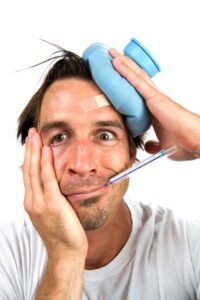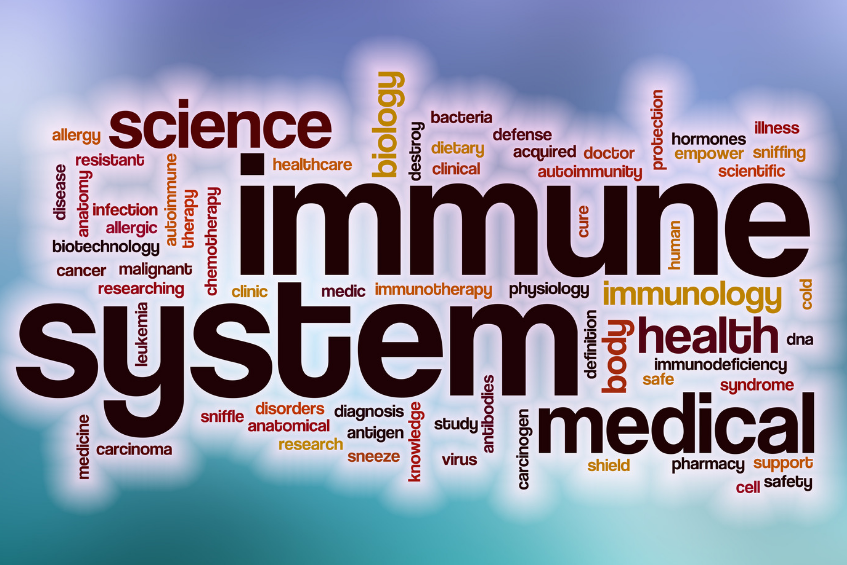Your “healthy” exercise program might be ruining your immune system. If you or your clients have been consistently feeling exhausted and drained after workouts or suffering too many colds this season, consider this.

Exercise has often been touted as the best medicine for a multitude of ailments. In the correct amount, it can be beneficial; but as with some many medications on the market, excess dosages can be harmful.
Exercise isn’t just a limitless source of healthy goodness; there comes a point when “healthy” spills over into “too much,” and we can actually improve our health by engaging in less of it. This is not a precept to which one generally expects a personal trainer to adhere, but after considerable research on the topic, there is a great deal of truth to this statement.
Between 60 and 90 % of dedicated amateur and professional athletes who do not over-train report, they have fewer colds/upper respiratory issues than their more sedentary counterparts, according to a June 2001 report by the President’s Council on Physical Fitness and Sports Research.
Dr. Mark Jenkins, Associate Team Physician for Rice University, writes on the SportsMedWeb site that improved immune function through moderate exercise is “especially true in older athletes, and it appears that regular exercise can help reduce the age-related decline in immune function.” However, knowing when to take a step back is just as critical as being able to push oneself out of a slump.
More Work Can Equal Less Potency
More than one component of the immune system may be weakened by excessive training, which is defined as working out intensely for more than 90 minutes. These include changes in the number and function of immune system cells, such as white blood cells, antibodies, and pro- and anti-inflammatory biochemicals such as cytokines.
During the 3 to 72 hours following an overly intense workout, there exists within our bodies a window of opportunity during which “viruses and bacteria may gain a foothold, increasing the risk of subclinical and clinical infection. Thus, the risk of upper respiratory tract infections can increase when athletes push beyond normal limits,” according to Jenkins.
There are all kinds of ways to determine when the point of excessive exercise has been reached. Some athletes have a keen sense of self-awareness, and simply “feel” when they could use a rest; others use various metrics, such as a lifting log or mileage count, to determine that their bodies need a day off. From a purely scientific perspective, however, one of the most interesting ways to approach this dilemma is from the vantage point of the immune system.
A healthy amount of exercise seems to provide an overall boost to the immune system. However, overdoing it may actually impair immune function. Endurance athletes such as marathon runners, distance swimmers, and triathletes regularly exhibit significantly depressed immune systems, especially with regard to upper respiratory tract infections. When elite athletes do get colds, their symptoms tend to last longer and be more severe than those of the average recreational gym-goer.
Too Much Of a Good Thing?
The researchers of one study undertaken to illustrate this point examined three groups of subjects: elite athletes, recreational athletes, and a sedentary control group. Their results were both interesting and definitive ~
- 66% of the elite athletes displayed upper respiratory issues
- The sedentary subject group suffered an illness rate of 45%
- The recreational athletes remained the healthiest of the 3, with only 22% succumbing to colds
The study became even more specific as it explored what aspects of exercise produced the dip in immune response ~
- Relatively long training sessions (1.5 hours or more), especially without refueling during the workout
- A reasonably high intensity, but not excessively difficult, training session
- Insufficient recovery periods between workouts
It is clear that exercise can bring about significant hormonal changes within the body. Most notably, it raises the levels of norepinephrine and cortisol, “stress hormones” that tend to suppress the immune system. The hormonal changes of exercise cause the numbers of immune cells (including leukocytes, or white blood cells) to drop during and immediately upon completion of the workout.
Many components of the immune system exhibit adverse change after prolonged, heavy exertion, such as the skin, upper respiratory tract mucosal tissue, lung and muscle tissue, and of course, in the bloodstream. A great majority of exercise immunologists believe that during this ‘open window’ of impaired immunity, viruses and bacteria may gain a foothold, increasing the risk of subclinical and clinical infection.The infection risk may be amplified when other factors related to immune function are present, including exposure to new pathogens, lack of sleep, emotional stress, malnutrition, and/or weight loss.
This belief was founded in the early 1990s with a study conducted by David Nieman, Ph.D. Dr. Nieman introduced the “J-shaped curve”, which clearly illustrates how regular moderate exercise may decrease the risk of upper respiratory infections while regular intense exercise may increase the risk of these infections.
A study of 10 elite male cyclists, results of which were published in 2010 in the Exercise Immunology Review, revealed that a long session of intense exercise (in this case, two hours of hard cycling) may temporarily boost some aspects of the immune system response (like certain white blood cell counts), but also temporarily depress other variables, such as phagocytic activity, which is the process used by the body to protect itself from infectious and noninfectious environmental particles and to remove unwanted cells.
Keep in mind that although that tough HIIT workout might be to blame for the sudden appearance of cold symptoms, the benefits derived from such high-intensity training far outweigh the negative aspects, so it is not necessary to avoid such workouts during cold and flu season simply in the name of remaining illness-free.
The safest bet is to increase one’s focus on recovery, which seems to mitigate the risk. “Even without exercise, lack of sleep and stress weaken your immune system and predispose you to get sick, and if you add a heavy workout on top of that, you’re even more vulnerable,” says Purvi Parikh, M.D., an allergist/immunologist with the Allergy & Asthma Network.
Dietary Interventions For Alleviating a Compromised Immune System
Immune cells need glucose to function properly, which our bodies obtain through the consumption of carbohydrates. Several studies have shown that overtraining on a low-carb diet (7-11% carbohydrate) produces a dramatic negative shift in the immune system. This confirms what most trainers preach to clients: athletes need enough carbohydrates to keep themselves properly fueled for the activity at hand.
No single food will magically fend off the flu, but certain nutrients take the lead in helping protect your body from the daily onslaught of bacteria, viruses, and other germs. Protein is one such key nutrient. The antibodies that help fight disease are comprised of proteins.
Many foods high in protein contain additional immune-boosting nutrients. Lean cuts of beef and pork, as well as protein derived from beans, soy, and seafood (especially oysters and crab), contains zinc—a mineral that helps raise the production of infection-fighting white blood cells. Studies have demonstrated that even mild zinc deficiencies can increase the body’s susceptibility to infections. Both almonds and cashews are good sources of protein as well as magnesium, both of which help support a healthy immune system.
Almost any kind of fresh fruit and vegetables are good for keeping the immune system properly functioning, but if choices must be made, opting for those rich in vitamins A, C, and E will always be beneficial. Vitamin A, which can be obtained from the consumption of delicious sweet potatoes, carrots, and dark leafy greens, helps white blood cells fight off infections more effectively; it also assists in regulating the immune system.
Deficiency of iron, zinc, or Vitamins A, E, B6, or B12 can be associated with excessive physical training, but no hard evidence exists to point to the theory that high-dose supplements will confer any improvement. Once the body suffers from an inadequate intake, increasing the amount will not immediately rectify the situation. Simply put, our bodies are unable to compensate for overtraining by eating differently in the immediate short-term.
Can Exercise Boost the Immune System?
Some studies show that “moderate intensity” exercise may cut down on the incidence of common colds. Moderate activity includes a 20- to 30-minute walk every day, strength training and/or cardio conditioning at the gym every other day, or biking a few times a week.
In a study appearing in the American Journal of Medicine, women who walked 30 minutes every day for 1 year suffered 50% as many colds as those who didn’t exercise. Researchers found that engaging in regular exercise may lead to a higher number of infection-fighting white blood cells circulating in the bloodstream.
In a separate study, researchers found that 65-year-olds who participated in regular exercise exhibited the same number of T-cells — a specific type of white blood cell — as that found in individuals half their age.
Are Workouts Safe With a Cold or Stuffy Nose?
Mild to moderate physical activity is considered safe even in the presence of a common cold, provided there is no accompanying fever. Exercise may even temporarily relieve mild congestion by opening nasal passages.
Generally speaking, most physicians deem exercise to be acceptable provided all of one’s symptoms are above the neck: runny nose, sore throat or sneezing. Symptoms presenting themselves below the neck, such as wheezing, coughing or gastric distress, point to skipping the gym and resting instead. Even under mild illness circumstances, reducing the intensity of a workout will still provide some exercise while not placing the body at risk for a more serious and/or debilitating cold or infection.
Your Bottom Business Line
While it may be tempting to encourage clients to “work through” their symptoms, in an effort to maintain your current income level, sage advice suggests taking a longer view than the next paycheck. We have dedicated ourselves to the preservation and improvement of clients’ physical wellbeing, and that does not always mean bigger muscles or improved VO2 max. Considering the entire person rather than his/her individually trained body parts, we must know when it is best to suggest rest and a day or two off from the gym, and when it is safe and appropriate to carry on with business as usual. Becoming familiar with which aspects of intensity can ramp up or depress the body’s immune function enables us to provide the best guidance to our clients.
REFERENCES
- https://www.ncbi.nlm.nih.gov/pubmed/11897880
- https://www.livestrong.com/article/331034-does-exercise-weaken-immune-system/
- https://paleoleap.com/exercise-immunity/
- https://www.ncbi.nlm.nih.gov/pubmed/17414793
- https://www.ncbi.nlm.nih.gov/pubmed/23112908
- https://www.shape.com/fitness/tips/your-really-freaking-hard-workout-making-you-sick
- https://www.today.com/health/7-easy-ways-boost-your-immune-system-2D80554874
- https://www.webmd.com/cold-and-flu/cold-guide/exercise-when-you-have-cold#1-2
- https://www.mayoclinic.org/healthy-lifestyle/fitness/expert-answers/exercise/faq-20058494


